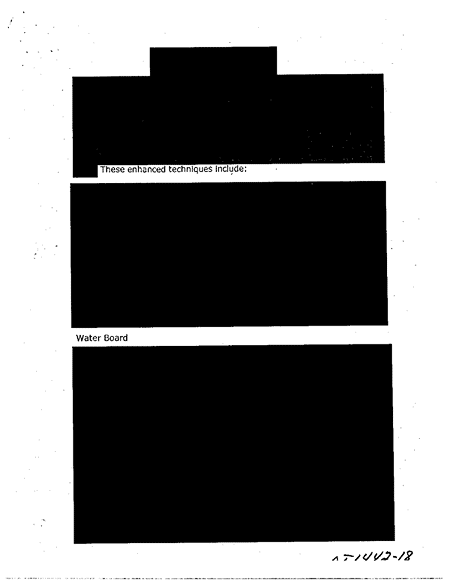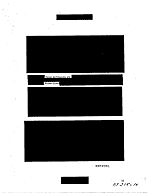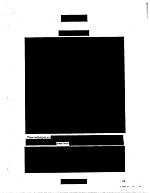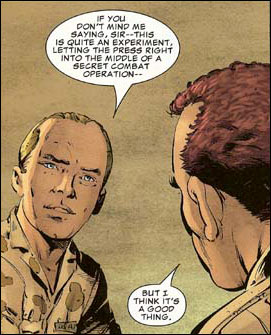cia
You Don't Know the Half of It
The ACLU has posted a handful of documents they’ve pried from the CIA about the use of waterboarding on prisoners in CIA custody.
After the Director of the CIA publicly admitted that the CIA has, in fact, used waterboarding, the agency could hardly argue that this was a state secret.
The documents are, of course, heavily redacted, an insolent gesture of spite to the court, the ACLU and concerned citizens. The graphic effect is comically absurd — and chilling to imagine what else lies beneath the black. Click below for a larger image.
“How are terror and counterterrorist networks visualized? How can we locate and visualize their clandestine operations and network structures, both on a real and virtual level? And how does the visualization of these networks correlate to an operational strategy of symbolic violence, coercive intimidation and political fear?”
Mapping the “War on Terror,” 3

A billboard I designed is up on display in Los Angeles. It’s part of a series of public art installations about the war, and will be on view until October 8, 2006.
The image is a map of Selected CIA Aircraft Routes and Rendition Flights 2001-2006, some of which transported prisoners to foreign countries to be interrogated and tortured. After years of silence and denial, the administration publicly acknowledged the flights in the last few weeks.
I worked with artist and geographer Trevor Paglen who provided the data. Trevor spent several years tracking down the flight information, and has a book out this month on his investigations, Torture Taxi: On the Trail of the CIA’s Rendition Flights. See this interview with him on Democracy Now! with co-author, journalist A.C. Thompson.
The billboard is located at 6150 Wilshire Boulevard, near South Fairfax Ave, between Beverly Hills and West Hollywood. Here’s a Google Map.
Clockshop, a public arts organization in Los Angeles, funded the display. You can read more about the project at http://clockshop.org/here.php
A few images, below:
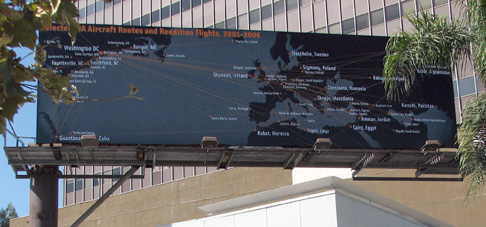

Domestic Policy
Another item I missed while out, on May 24, President Bush appointed Karl Zinsmeister as his chief domestic policy advisor (replacing Claude Allen who resigned in February when caught stealing from Target.) Judging from the appointment, the domestic agenda seems more about propaganda than poverty.
His qualifications? Zinsmeister was editor of The American Enterprise, the magazine of the American Enterprise Institute, a neo-conservative think tank whose stated mission is to support the “foundations of freedom — limited government, private enterprise, vital cultural and political institutions, and a strong foreign policy and national defense.” Among the organization’s funders are both Microsoft and the Scaife family.
Also on his resume, in 2003, Zinsmeister was embedded as a military reporter with the 82nd Airborne in Iraq. His Iraq experience is chronicled in Combat Zone: True Tales of GI’s in Iraq, which Zinsmeister wrote for Marvel Comics. [source] The comic excludes accounts of torture and detainee abuse by the 82nd Airborne later documented by Human Rights Watch.
Further qualifying him, is Zinsmeister’s 2002 essay When Art Becomes Inhuman, a critique of modern art, liberals, and, of course, Manhattan. [source]. His rant against abstraction is an ironic reversal from the days when the CIA helped promote abstract expressionism at the expense of social realism to keep the Commies at bay. Nowadays, with abstraction duly en-framed in the canon of modern art, it makes easy fodder for the ‘liberals are elitist snobs’ line of right-wing populists.
Among his accusations, is one about lefty directors of musical theater who “believe audiences should absorb ideological messages in the theater, not beautiful songs.” This is of course coming from his own ideological screed. But it’s also a further note of just how ideological the apparent ‘invisibility’ and ‘neutrality’ of beauty really is.
Psyops Comics IV: Viet Nam

“Honey, what do they say in those leaflets?”
“They are the same as those wall posters, as well as the announcements on the radio yesterday. The two Communists Ba Luong and Hai Gon are presently hiding our village in order to collect taxes. I am determined to report to the Phoenix Operation Committee because I know their hiding place.”
We’ve seen the CIA use comics to fight the Sandinistas; the FBI to fight the Black Panther Party; and with the Comics Code Authority to portray the CIA, ethnic advancement agencies, and the economically privileged in a positive light for U.S. comics readers. The CIA also used comics during the Vietnam War as part of its psychological operations and counterinsurgency campaign.
The comic book, “Mr. Ba’s Family and the Phoenix Operation,” was prepared and disseminated by U.S. forces in South Viet Nam under Operation Phoenix. Operation Phoenix was designed to assassinate or imprison members and collaborators of the National Liberation Front, the united front that brought together Communists and non-Communists to liberate Viet Nam from foreign control.
“Phoenix offices were set up from Saigon down to the district level. Their functions were to: (1) collate intelligence about the ‘Vietcong Infrastructure’; (2) interrogate civilians picked up at random by military units carrying out sweeps through villages; (3) ‘neutralize’ targeted members of the NLF. This third task was often carried out by CIA-led Vietnamese organized into Provincial Reconnaissance Units.”
The comic the fictional story of “Mr. Ba,” who is conviced and eventually rewarded for informing the U.S. military about where the Viet Cong are hiding in his village.
Read more about the comic or See pages from the comic and an English translation. Note, the page and images load slowly.)
On July 19, 1971, William Colby, the CIA officer in charge of Operation Phoenix, testified before a Subcommittee of the House Committee on Government Operations, that between 1968 and May 1971, 20,587 alleged Vietcong sympathizers were executed as a result of the Phoenix Program. The government of South Vietnam credited Phoenix with 40,994 deaths. Vietnamese who were taken into custody were often tortured before being executed. U.S. military-intelligence officer, K. Barton Osborn testified that none of those ever held for questioning lived through the process. (New York Times, August 3, 1971, p. 10.)
The Memory Hole has posted a collection of CIA documents from the Phoenix Program online.
When I Hear the Word “Gun”
“Slavoj Zizek also mistook the origins of the inversion of Goering’s - or Hanns Johst’s - remark (Letters, 15 April). ‘When I hear the word “gun”, I reach for my culture’ was not a ‘leftist slogan’ but a remark made by Malcolm Muggeridge in an article published, I think, in the New Statesman around 1967. He was writing in response to the revelation that the CIA had been financing a number of literary and cultural magazines around the world, including Encounter, and funding the export of Jackson Pollock and other exponents of Abstract Expressionism from America to Europe. It was meant as a joke, but it throws a useful light on a period when art and politics were rather more intimately linked than they are perceived to be today.”
Richard Gott, letter to the London Review of Books.
Props to Drapetomaniac for the link.


